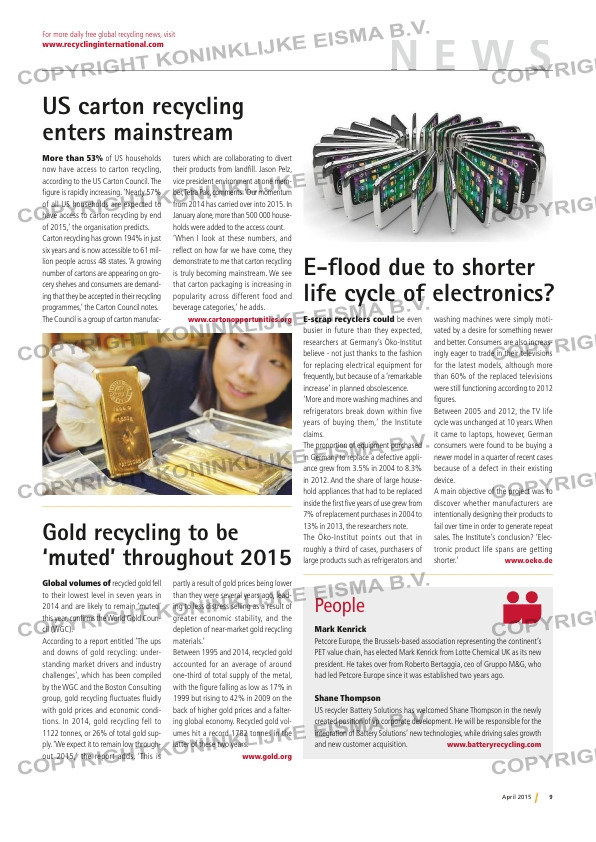Page 9 from: April 2015

N E W S
9April 2015
For more daily free global recycling news, visit
www.recyclinginternational.com
People
Mark Kenrick
Petcore Europe, the Brussels-based association representing the continent’s
PET value chain, has elected Mark Kenrick from Lotte Chemical UK as its new
president. He takes over from Roberto Bertaggia, ceo of Gruppo M&G, who
had led Petcore Europe since it was established two years ago.
Shane Thompson
US recycler Battery Solutions has welcomed Shane Thompson in the newly
created position of vp corporate development. He will be responsible for the
integration of Battery Solutions’ new technologies, while driving sales growth
and new customer acquisition. www.batteryrecycling.com
Global volumes of recycled gold fell
to their lowest level in seven years in
2014 and are likely to remain ‘muted’
this year, confi rms the World Gold Coun-
cil (WGC).
According to a report entitled ‘The ups
and downs of gold recycling: under-
standing market drivers and industry
challenges’, which has been compiled
by the WGC and the Boston Consulting
group, gold recycling fl uctuates fl uidly
with gold prices and economic condi-
tions. In 2014, gold recycling fell to
1122 tonnes, or 26% of total gold sup-
ply. ‘We expect it to remain low through-
out 2015,’ the report adds. ‘This is
partly a result of gold prices being lower
than they were several years ago, lead-
ing to less distress selling as a result of
greater economic stability, and the
depletion of near-market gold recycling
materials.’
Between 1995 and 2014, recycled gold
accounted for an average of around
one-third of total supply of the metal,
with the fi gure falling as low as 17% in
1999 but rising to 42% in 2009 on the
back of higher gold prices and a falter-
ing global economy. Recycled gold vol-
umes hit a record 1782 tonnes in the
latter of these two years.
www.gold.org
Gold recycling to be
‘muted’ throughout 2015
More than 53% of US households
now have access to carton recycling,
according to the US Carton Council. The
fi gure is rapidly increasing. ‘Nearly 57%
of all US households are expected to
have access to carton recycling by end
of 2015,’ the organisation predicts.
Carton recycling has grown 194% in just
six years and is now accessible to 61 mil-
lion people across 48 states. ‘A growing
number of cartons are appearing on gro-
cery shelves and consumers are demand-
ing that they be accepted in their recycling
programmes,’ the Carton Council notes.
The Council is a group of carton manufac-
turers which are collaborating to divert
their products from landfi ll. Jason Pelz,
vice president environment at one mem-
ber, Tetra Pak, comments: ‘Our momentum
from 2014 has carried over into 2015. In
January alone, more than 500 000 house-
holds were added to the access count.
‘When I look at these numbers, and
refl ect on how far we have come, they
demonstrate to me that carton recycling
is truly becoming mainstream. We see
that carton packaging is increasing in
popularity across different food and
beverage categories,’ he adds.
www.cartonopportunities.org
US carton recycling
enters mainstream
E-scrap recyclers could be even
busier in future than they expected,
researchers at Germany’s Öko-Institut
believe – not just thanks to the fashion
for replacing electrical equipment for
frequently, but because of a ‘remarkable
increase’ in planned obsolescence.
‘More and more washing machines and
refrigerators break down within five
years of buying them,’ the Institute
claims.
The proportion of equipment purchased
in Germany to replace a defective appli-
ance grew from 3.5% in 2004 to 8.3%
in 2012. And the share of large house-
hold appliances that had to be replaced
inside the fi rst fi ve years of use grew from
7% of replacement purchases in 2004 to
13% in 2013, the researchers note.
The Öko-Institut points out that in
roughly a third of cases, purchasers of
large products such as refrigerators and
washing machines were simply moti-
vated by a desire for something newer
and better. Consumers are also increas-
ingly eager to trade in their televisions
for the latest models, although more
than 60% of the replaced televisions
were still functioning according to 2012
fi gures.
Between 2005 and 2012, the TV life
cycle was unchanged at 10 years. When
it came to laptops, however, German
consumers were found to be buying a
newer model in a quarter of recent cases
because of a defect in their existing
device.
A main objective of the project was to
discover whether manufacturers are
intentionally designing their products to
fail over time in order to generate repeat
sales. The Institute’s conclusion? ‘Elec-
tronic product life spans are getting
shorter.’ www.oeko.de
E-flood due to shorter
life cycle of electronics?
RI-3 NEWS.indd 9 30-03-15 10:07



